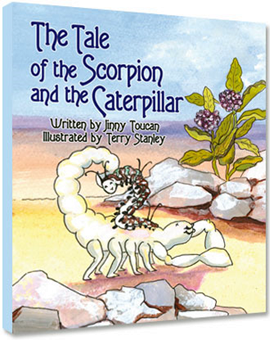

Creating Beauty from Grief: “The Tale of the Scorpion and the Caterpillar”
by Katie O'Sullivan
Losing a child is every mother’s nightmare. Jinny Toucan lived through the nightmare when one of her two adult sons passed away at the age of 23, just after graduating from Rice University.
“The grief of losing my son Tarik was overwhelming,” says Jinny. “Writing was a form of deep healing for me. I wanted to reach out to those who lost a loved one.”
Tarik’s passing started Jinny on a path of spiritual exploration, bringing her back to the days of her boys’ childhoods, and the stories she would both read from books and weave from her imagination. “Children have a way of seeing things in the most simplistic way,” she explains.
She wrote and published her first children’s book last spring, The Tale of the Scorpion and the Caterpillar. The proceeds from the book are donated to the Tarik Toukan Memorial Scholarship Fund .
Reminiscent of Aesop’s fables, she anthropomorphizes the kingdoms of the caterpillars and scorpions, who are real-world natural enemies. The story teaches many lessons about having compassion and understanding for different cultures, as well as dealing with loss.
Gili, the caterpillar princess, and Daev, the scorpion heir, go on separate journeys of discovery, and end up literally thrown together. “They met by synchronicity,” says Jinny. “I feel that nothing is by chance…it’s for a reason.”
Traveling through the treacherous desert together, the pair learn about each other, and find that their strengths and weaknesses complement each other. They fall in love, despite their differing worlds, accepting and valuing each other as individuals.
Jinny grew up in Taunton, Massachusetts, and has spent the last thirty years living overseas in Jordan and Dubai. yay
These days she divides her time between Cape Cod and the Middle East, two very different places. One assumes that she knows firsthand about cultural differences and the importance of valuing the individual.
Though most of the story deals with acceptance and the importance of living each moment as it unfolds, the book also opens the door for discussion about death. The book uses the allegory of the caterpillar’s metamorphosis into a butterfly to represent death.
The caterpillar kingdom thinks the cocoons that eventually claim their elders are a plague. They don’t understand it’s actually the start of the next phase of their lives, leaving the shell of their old body and transforming into another being.
When Gili transforms into a butterfly, Daev thinks she is gone forever, but then discovers she’s now in another form – a butterfly – and always with him.
The butterfly, whom Daev can no longer talk with, can be interpreted as the spirit or the soul. Gili has become an angel watching over Daev as he continues on alone. At the end, Gili is happy that Daev has figured out she is the butterfly.
“We will forever be connected,” Gili thought and laughed. “Such a strange pair indeed – a scorpion and a butterfly.”
On the dedication page, Jinny writes “As I looked at the lives of scorpions and caterpillars, I realized that loss is as much a part of life as birth. For as we enter this world through birth, we leave a place from which we came, which in a sense is our first loss.”
She adds, “I hope this book will recapture your childlike openness to explore the possibility that life and love are eternal.”
The hardcover book has fifty pages broken into seventeen short chapters, with simple black and white illustrations by Terry Stanley mixed throughout.
There is a glossary in the back of words that might be unfamiliar to younger readers, and lots of real-life facts about caterpillars, butterflies and scorpions sprinkled into the story.
The adventure is engaging for a wide range of ages, from read-to-me levels up through middle school. Even adults will find comfort in her gentle fable.
 |
Jinny wants readers of all ages to be able to learn the lessons she has learned. “If we observe the life of a spider,” explains Jinny, “as he spins an amazing web, glistening in the sun, we could find some answers there.
"In fact, our lives are woven much like this web with twists and turns that eventually end up in some sort of pattern. And the death of a loved one is a ripping, gaping hole in the middle of this web we call life.”
How is the web rewoven? Jinny points out that the passage of time does not magically pull the web back together. Instead, the web must be “rewoven with love, energy and strength.”
The web is eventually rewoven, but it will never be exactly the same. “We don’t recover from death,” she says, “but we can allow others to help reweave our web.”
Adds Jinny, “My hope is that I can help someone reweave the gaping hole in their life, from the pain of losing a loved one. If we, as women, can reach out and help in some way, even a small way, it makes a difference.”

The Tale of the
Scorpion
and the Caterpillar
is available at www.amazon.com and at Jinny’s website www.scorpionandcaterpillar.com
Email the author at ginny@jinnytoucan.com
Katie O'Sullivan is the editor of this magazine. She lives and writes from her home on Cape Cod, and is currently working on a children’s book of her own.